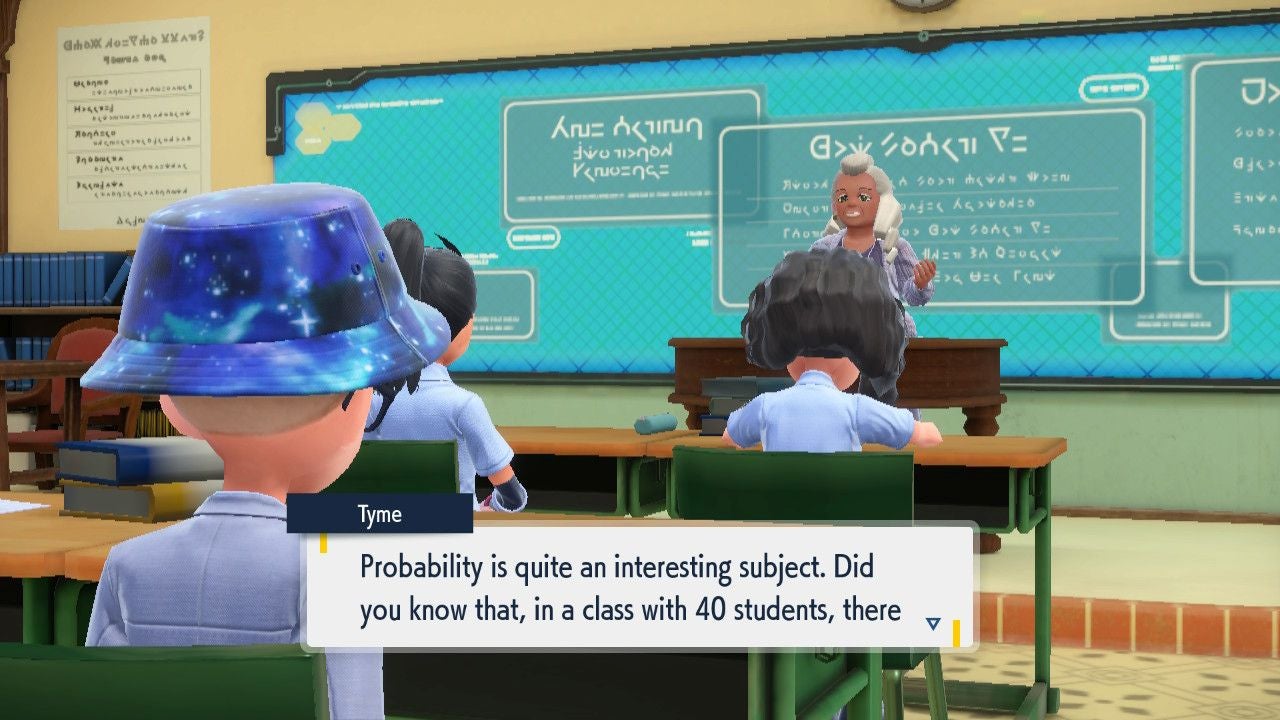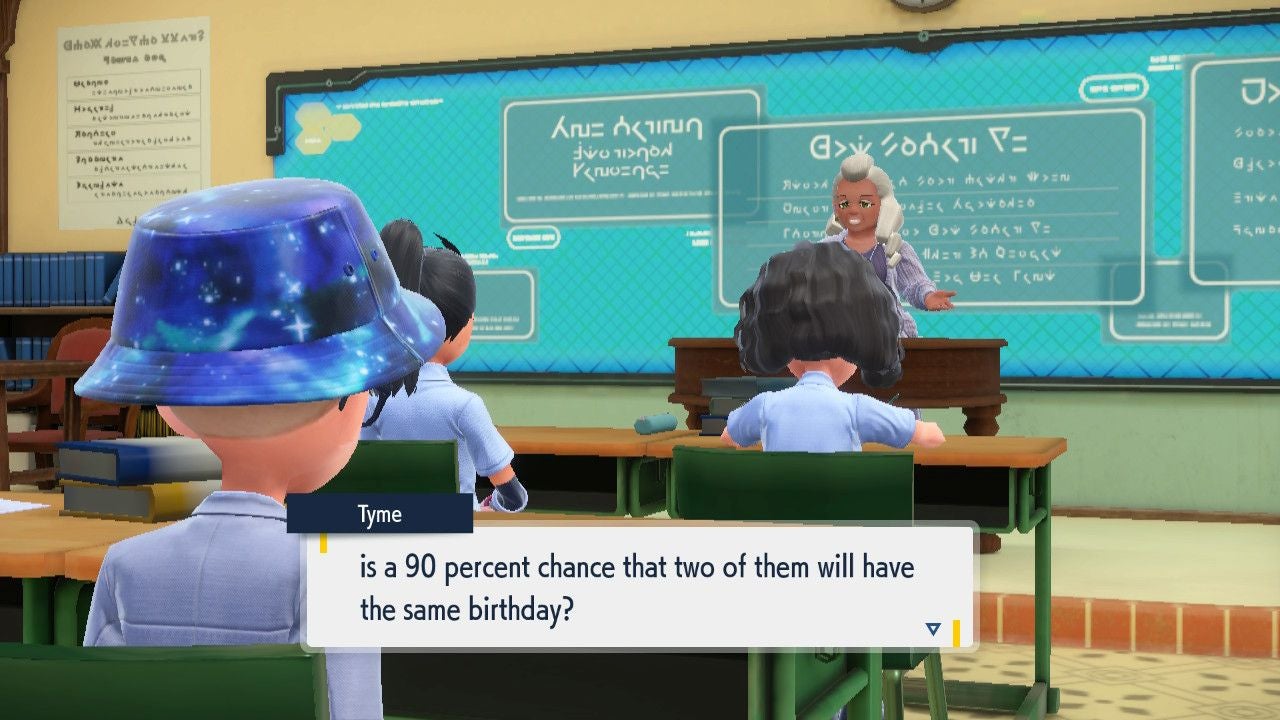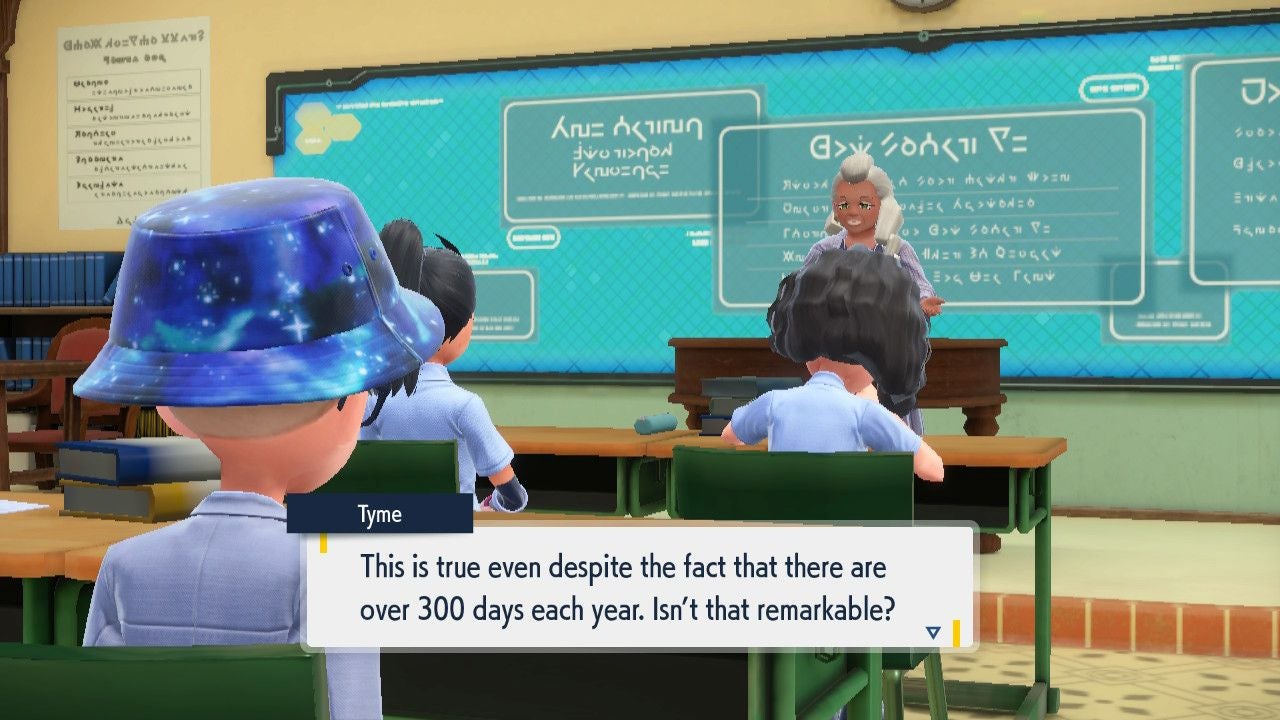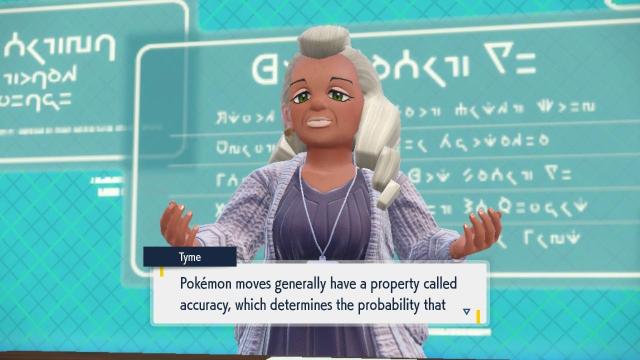Within the many, many aspects of the new Pokémon Scarlet And Violet (PSV), from its Gym campaign to its Titan-battling storyline, is one feature that is easily forgotten: its Academy lessons. For the most part, that’s for a good reason — they’re astoundingly boring. But there’s one moment, in the middle of a maths lesson, that made me whoop with joy.
PSV’s Academy classes are such an odd aspect of the game. As you begin, joining your school, finding your dorms, getting to know the classrooms and the facilities, it feels as though it’s going to be a pivotal aspect of the game. But then you’re told, “No, don’t worry about this place, go off into the world and find your treasure!” In a very strange piece of design, there’s nothing that rubber-bands you back to the Academy as you play, no narrative reason to ever come back to base. Yet, if you do, you’ll discover there are a bunch of little nuggets and extras tucked away there, between the tedium.
There are seven lesson types available — Biology, Maths, History, Languages, Battle Studies, Art, and Home Economics — each with six lessons, two sets of tests, and their own unique teachers. If you attend the lessons, the teachers can then be interacted with outside of class, allowing you to develop (clearly deeply inappropriate) relationships with them, growing closer and more trusted the more you interact. On top of that, there’s also the Director to get to know, and a whole bunch of stuff hidden away in the main lobby’s library. For an aspect the game entirely forgets to tell you about, there’s a lot to do.
The main issue is, the core of it is dreadful. The lessons are dreary, mostly perfunctory, and the process of clicking through them all is laborious and extremely time-consuming. On top of that, the “midterms” and “finals” you take often feature questions that haven’t been taught, and occasionally the complexity of the information suddenly spikes, and is abysmally communicated. Good grief, the maths lessons switch from asking you insipid questions to suddenly asking you to juggle complex percentages and probabilities for numbers that are gone from the screen by the time you’re picking an answer.
There’s one thread, however, that’s absolutely worth playing: History. Not because it’s better written, but because it opens up another chain of quests to complete in the main world, if you pursue the “relationship” with Ms. Raifort. This links into those weird chained doorways you might have found, making sense of those disappearing stakes, and it’s just flat-out weird that this is hidden behind the dreadful lessons.
So yeah, it sucks, and the only reason to drag yourself through it is to be able to complete the relationship storylines with staff, or to get the valuable XP candies you receive for passing tests. Except!

Except!
There’s a moment within that run of muddling maths lessons that absolutely delighted me. Ms. Tyme, your erstwhile maths teacher, is trying to get the class enthused about probability, and drops in an example of a surprising outcome as a throwaway explanation of the mysteries of probability.
Because it’s part of these cursed lessons, it’s not actually mentioned in the lesson focused on probability but rather, entirely apropos of nothing, in the following class. But who cares, because it’s great! Ms Tyme declares,
Probability is quite an interesting subject. Did you know that, in a class with 40 students, there is a 90 per cent chance that two of them will have the same birthday?
This is true despite the fact that there are over 300 days each year. Isn’t that remarkable?
Now, clearly I want to mock that “over 300 days each year” line, but I genuinely have no idea if Pokémon is set in our universe. Maybe their planet loops around their sun every 301 to 305 days, depending on the whim of Arceus? Let’s not presume, but instead focus on what’s important: Their probability works the same as ours.
I love this birthday fact. I love it because it’s so counter-intuitive, yet so relatable, yet so incredibly complicated to prove.
Known as the Birthday Problem, it’s often suggested as a “paradox,” despite being nothing of the sort. It’s just maths, or a “veridical paradox” according to clever grown ups — one that appears absurd, but is entirely reasonable. And it’s so fun because the chances of two people sharing a birthday tips over 50 per cent once you’ve got only 23 people in a room.

23 people, with 365 days they could be born on, yet you’ve got a better than 50-50 chance that two will have been born on the same day. At 30 people (a typical class size), that chance tips over 70 per cent, and as Ms. Tyme says, at 40 people you’re on 89.1 per cent. Get to 50 people, and you’ve got a 97 per cent chance of two people sharing a birthday. It’s all but guaranteed. And even then, it’s still so weird to get your head around.
Yet, simply because the maths works out, it’s something people can identify with anecdotally. Seven out of 10 people will have been in a class at school where two kids had the same birthday.
So…why? Well, think about it a different way. We need to start thinking about what the chances are that people don’t have the same birthday.
If you’ve two people in a room, the chances they have the same birthday are 1 in 365. But flip it: the chances that they don’t have the same birthday are 1 -1/365. Which works out to .997, or close to 1. It’s very unlikely that two people, picked at random, have the same birthday. (And for useful perspective, your chances of not winning the New York state lottery are 45,057,473/45,057,474, or 0.9999999778 — don’t play lotteries.)

With two people, you’ve got a great chance of not having two birthdays clash. But what if you then repeated this another 39 times? The chances are still small, that 39 other people would have the same birthday as that first guy, because you’re running a 0.003 chance each time.
But that’s not the sum here. You’re running that same odds of all 40 people against the other 39 people. That’s 780 different birthday comparisons. So if that 364/365 chance of something not happening is run 780 times? That’s (364/365)^780, which equals 0.118. Flip it back, and with 40 people in that room, the chances of no one having the same birthday is 0.882, or near as dammit to 90 per cent.
Which is all to say, if you compare 40 people against all other 40 people, it becomes incredibly difficult to keep avoiding that seemingly low chance. You’re simply running the odds too many times for it not to become rather likely.
Now, I’m no mathematician, so there’s a fair chance I’ll have something wrong in one of the calculations above. But I’m pleased to report that we’re not relying on me for the Birthday Problem being true!

Leave a Reply